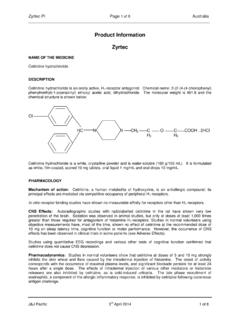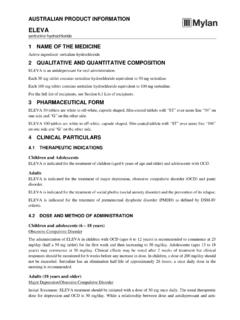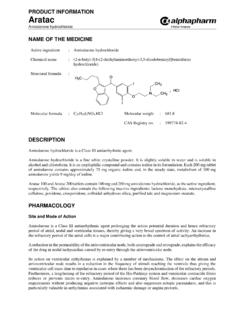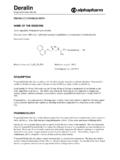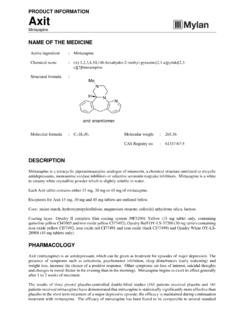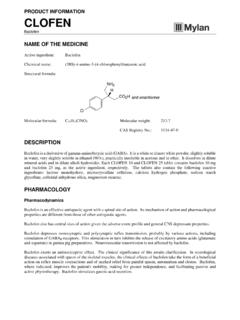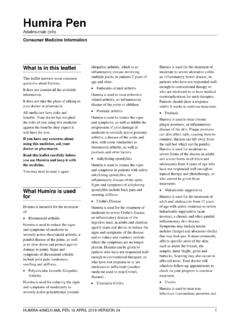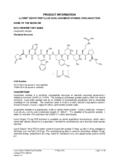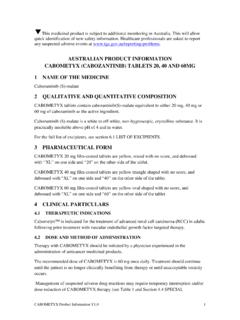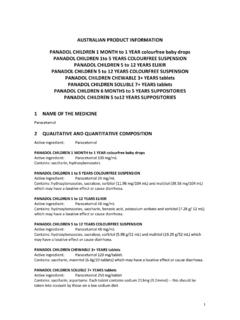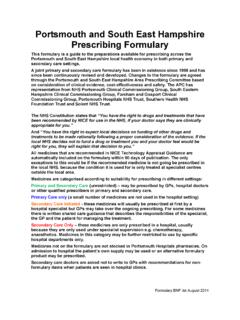Transcription of Zircol - Medicines
1 PRODUCT INFORMATION. Zircol lercanidipine hydrochloride name OF THE medicine . Active ingredient : lercanidipine hydrochloride Chemical name : 1,4 Dihydro 2,6 dimethyl 4 (3 nitrophenyl) 3,5 pyridinedicarboxylic acid 2 [(3,3 diphenylpropyl)methylamino] 1,1 dimethylethyl methyl ester hydrochloride Structural formula : Molecular formula : Molecular weight : CAS Registry no. : 132866 11 - 6. DESCRIPTION. lercanidipine is a dihydropyridine derivative. It is a racemate due to the presence of a chiral carbon atom at position 4 of the 1,4-dihydropyridine ring. lercanidipine hydrochloride (CAS: 132866-11-6) is a microcrystalline, odourless, citrine powder, readily soluble in chloroform and methanol, practically insoluble in water.
2 Octanol:water partition coefficient (LogP): Zircol contains the active ingredient, lercanidipine hydrochloride. The tablets also contain lactose, cellulose - microcrystalline, crospovidone, povidone, magnesium stearate, Opadry Yellow film coating system 03F82659. (10mg tablet. Proprietary Ingredient Number: 106579) and Opadry Pink film coating system 03F84645 (20mg tablet. Proprietary Ingredient Number: 106580). PHARMACOLOGY. Pharmacodynamics lercanidipine is a calcium antagonist of the dihydropyridine group and selectively inhibits the transmembrane influx of calcium into cardiac and vascular smooth muscle, with a greater effect on vascular smooth muscle than on cardiac smooth muscle.
3 The antihypertensive action is due to a direct relaxant effect on vascular smooth muscle which lowers total peripheral resistance and hence blood pressure. lercanidipine has a prolonged antihypertensive activity because of its high membrane partition coefficient. It is devoid of negative inotropic effects and its vascular selectivity is due to its voltage-dependent calcium antagonist activity. Since the vasodilatation induced by lercanidipine hydrochloride is gradual in onset, acute hypotension with reflex tachycardia has rarely been observed in hypertensive patients.
4 As for other asymmetric 1,4-dihydropyridines, the antihypertensive activity of lercanidipine is mainly due to the (S) enantiomer. Zircol PRODUCT INFORMATION 2. No significant effects on ECG have been seen. Pharmacokinetics Absorption lercanidipine is completely absorbed after oral administration. Peak plasma levels of ng/mL and ng/mL occur hours after dosing with 10 mg and 20 mg, respectively. The absolute bioavailability of lercanidipine is about 10%, because of high first pass metabolism. The bioavailability increases 4-fold when lercanidipine is ingested up to 2 hours after a high fat meal, and about 2-fold when taken immediately after a carbohydrate-rich meal.
5 Consequently, lercanidipine should be taken at least 15 minutes before a meal. A bioavailability study was conducted comparing the generic Zircol lercanidipine hydrochloride 20mg tablets with the originator lercanidipine hydrochloride 20mg tablets. The generic and originator mean C max for R- lercanidipine was ng/mL and ng/mL respectively, and the generic and originator mean C max for S- lercanidipine was ng/mL and ng/mL respectively. The C max point estimate for R- lercanidipine was with the 90% confidence interval between and , and the Cmax point estimate for S- lercanidipine was with the 90% confidence interval was between and The mean AUC point estimate for R- lercanidipine was with the 90% confidence interval between and , and the mean Mean AUC.
6 Point estimate for S- lercanidipine was , the 90% confidence interval was between and The Tmax for both the generic and originator tablets was 2 hours. With oral administration, lercanidipine exhibits non-linear kinetics. After 10, 20 or 40 mg, peak plasma concentrations observed were in the ratio 1:3:8 and areas under plasma concentration-time curves in the ratio 1:4:18, showing a progressive saturation of first pass metabolism. Accordingly, bioavailability increases as dosage increases. The two enantiomers of lercanidipine have a similar time to peak plasma concentration.
7 The peak plasma concentration and AUC are, on average, higher for the (S) enantiomer. No in vivo interconversion of enantiomers is observed. Distribution Distribution of lercanidipine from plasma to tissues and organs is rapid and extensive. Serum protein binding exceeds 98%. The free fraction of lercanidipine may be increased in patients with renal or hepatic impairment as plasma protein levels are decreased in these disease states. Metabolism As for other dihydropyridine derivatives, lercanidipine is extensively metabolised by CYP3A4. It is predominantly converted to inactive metabolites; no parent drug is found in the urine or faeces.
8 About 50% of the dose is excreted in the urine. Excretion The mean terminal elimination half-life of S- and R- lercanidipine enantiomers is and hours, respectively. No accumulation was seen upon repeated administration. The therapeutic activity of lercanidipine lasts for 24 hours, due to its high binding to lipid membranes. Elderly patients In elderly patients, the pharmacokinetics of lercanidipine are similar to those observed in the general population. Hepatic Impairment A study in patients with mild hepatic impairment (Child-Pugh class A) showed that the pharmacokinetic behaviour of the drug is similar to that observed in the general population.
9 No studies have been undertaken in patients with moderate or severe hepatic impairment. Zircol PRODUCT INFORMATION 3. Renal impairment In patients with severe renal dysfunction (creatinine clearance <12 mL/min) or dialysis-dependent patients, plasma levels were increased by about 70%. As a consequence, the drug should be contraindicated in severe renal impairment. CLINICAL TRIALS. Placebo-controlled studies lercanidipine has been compared to placebo in four (4) to 16-week studies, involving 671 patients with mild- moderate essential hypertension. All studies used a 3-week placebo run-in period.
10 Endpoints were diastolic and systolic blood pressure 24 hours post dose. Both 10 mg and 20 mg once daily significantly lowered diastolic and systolic blood pressure compared to placebo, and the reduction in blood pressure was maintained throughout the 24 hour dosing period. Diastolic blood pressure changes observed after 4-week treatment with 10-20 mg daily lercanidipine ranged between 8 and 13 mmHg, as compared to 3-6 mmHg induced by placebo. Studies with 24-hour ambulatory blood pressure monitoring have documented that the antihypertensive effect of lercanidipine is maintained throughout the 24 hour dosing period, with limited variations between peak (5-7.)
